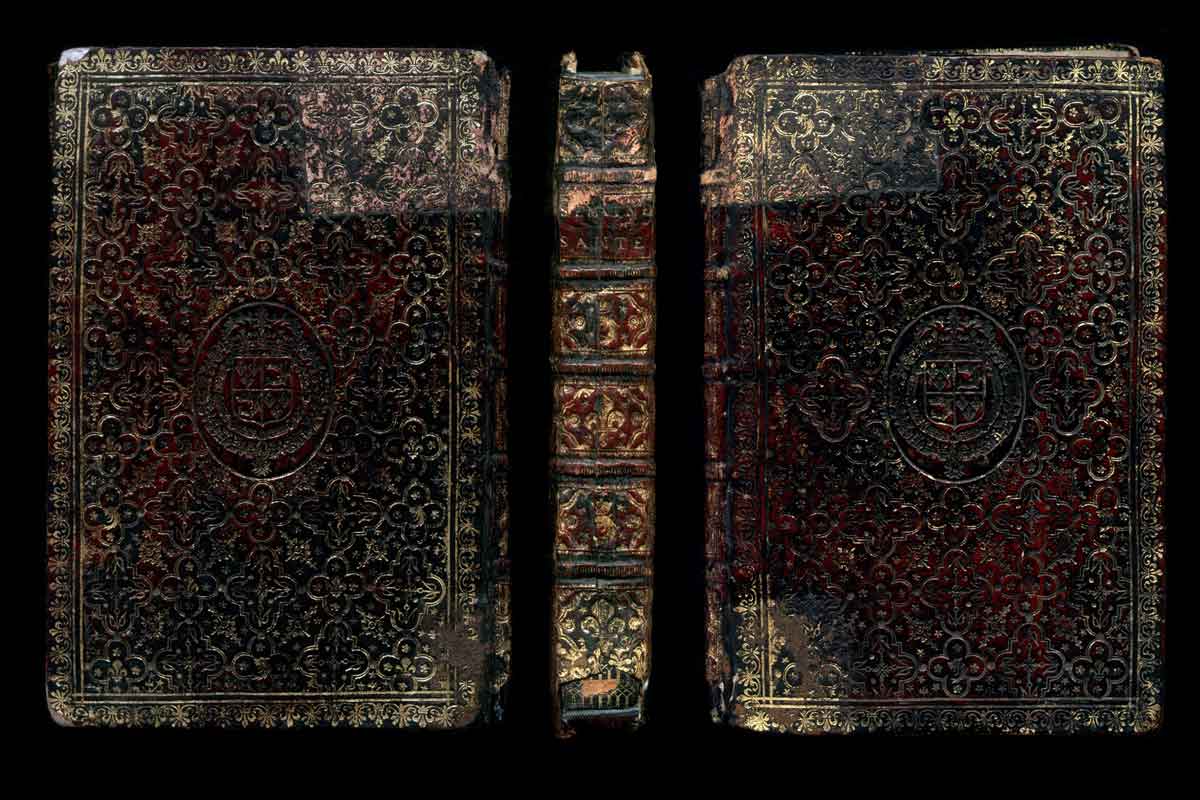

| When I first spotted this binding on eBay I was sure that I had seen already another binding similar. The tools probably those of Boyet although the style quite different from most of his work. Fortunately for everyone concerned this binding was in far from perfect condition and I scooped it up for a scant few euros. I have read that, in the not so distant past certain Polynesian tribes believed that objects such as our personal belongings take on a certain power, or mana, the more powerful the chief the stronger the mana of his possessions. Imagine then the mana of the binding shown above, it once belonged to Louis de France, first son of Louis XV and father of Louis XVI. Admittedly it doesn't look as impressive as it once did, the Office that this binding was made for is no longer inside. A closer inspection shows that the spine has been cut lengthwise through the middle, the Office removed and a somewhat smaller, Offices des carmelites glued in. We need not dwell on why someone would brutalize a Boyet in this fashion. Below, I have gathered now some interesting parallel Boyets which we can now compare with this powerful treasure from the past. |
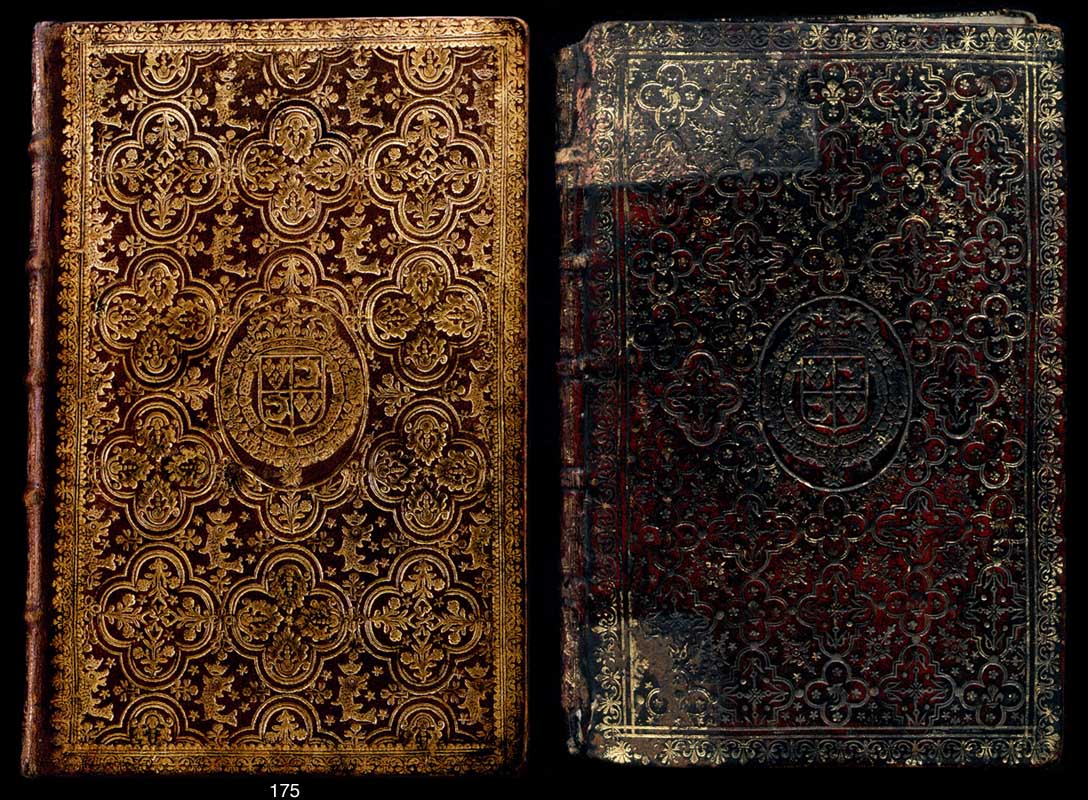
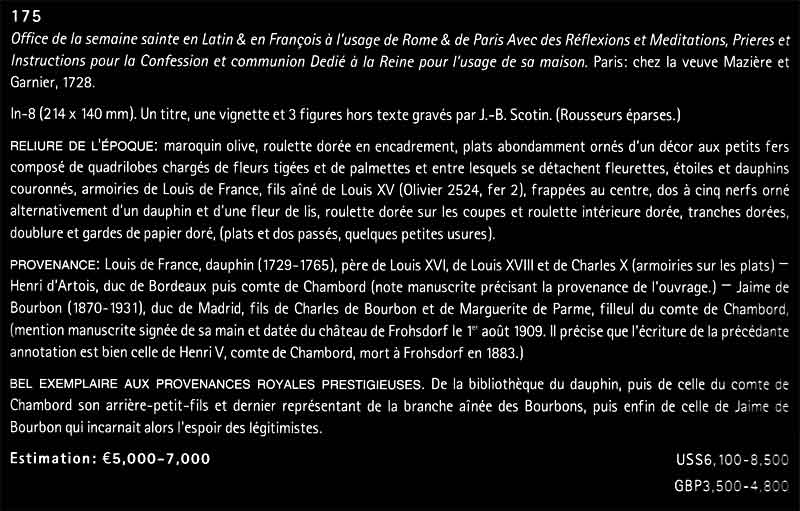
| Our first comparative binding is found in a 2004 Christie's catalogue, I have also reproduced here, the description of this item (lot #175), here we are informed that the coat of arms is that of Louis de France, son of Louis XV, (Olivier 2524, fer 2), that the spine has five raised bands , and the compartments are decorated with alternating fleur de lis and dauphin imprints. This then would appear to be the same as our eBay example. Although there is a considerable difference in price! |
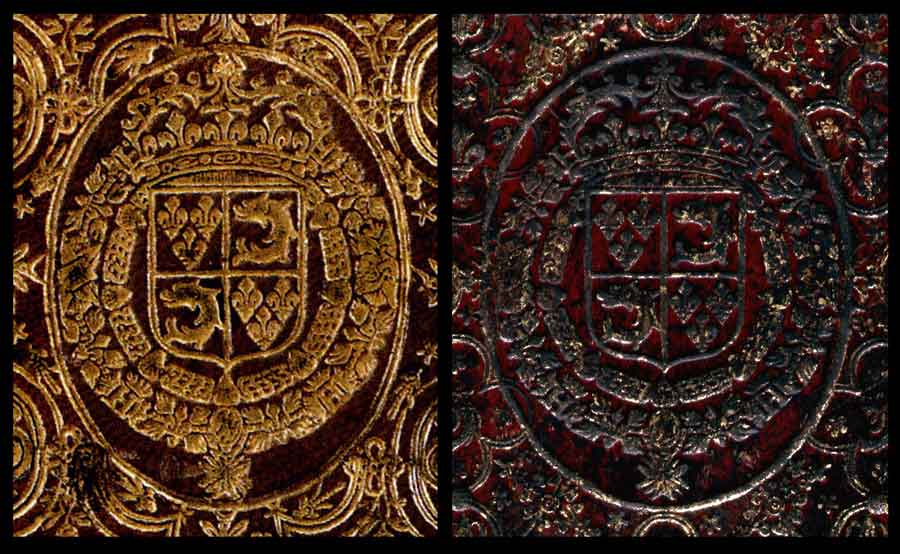
| (Catalogued in the Manuel de Amateur de Reliures Armoriees Francaise by Olivier (Dr. E.), Hermal (G.), Roton (Capt. R. de). PARIS, Bosse - 1924-1938, see Vingt-sixieme Serie (SOUVERAINS ET PRINCES FRANCAIS) Troisieme partie : Planches 2502 a 2535, Pl. 2524 (fer 2)). |
| Christie's item 175 is listed as being (214 x 140 mm) however I have measured very accurately the coat of arms using a 600 dpi scan and then reproduced the 175 binding with armories at the correct size. This results in a binding that is about 219 in height, this is very likely the right size of a 1728 Mazieres et Garnier, OSS. This is very comparable to the eBay binding and I would not be surprised if the 1728 Mazieres et Garnier OSS, was the one that was originally in this binding. |
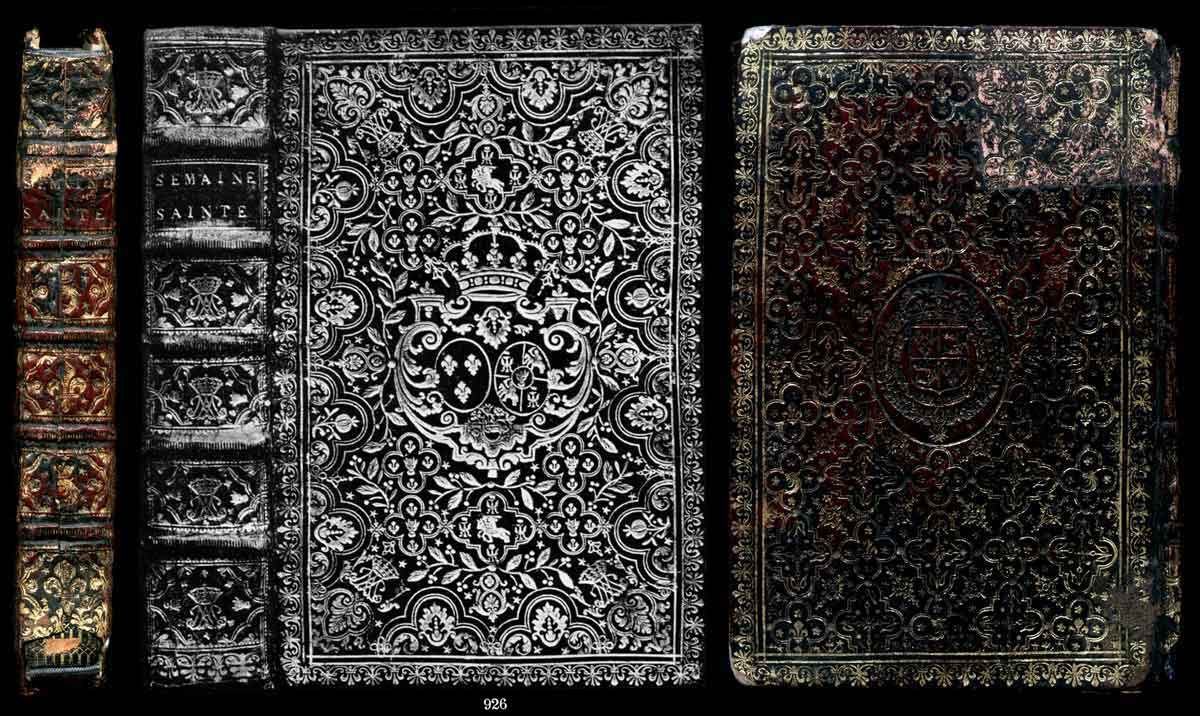

| The binding shown above as number 926 comes from a 1934 auction catalogue, Lucien Gougy, deuxieme Partie, Drouot Paris. What a lucky break to find this which is another 1728 Mazieres et Garnier, OSS. (see the lot information reproduced above). Here we see many identical features, outer dentelle roulette, the treatment of the spine compartments and bands as well as the same palette. We are going to look at each of these in detail so that we will be able to quickly recognize each one. |
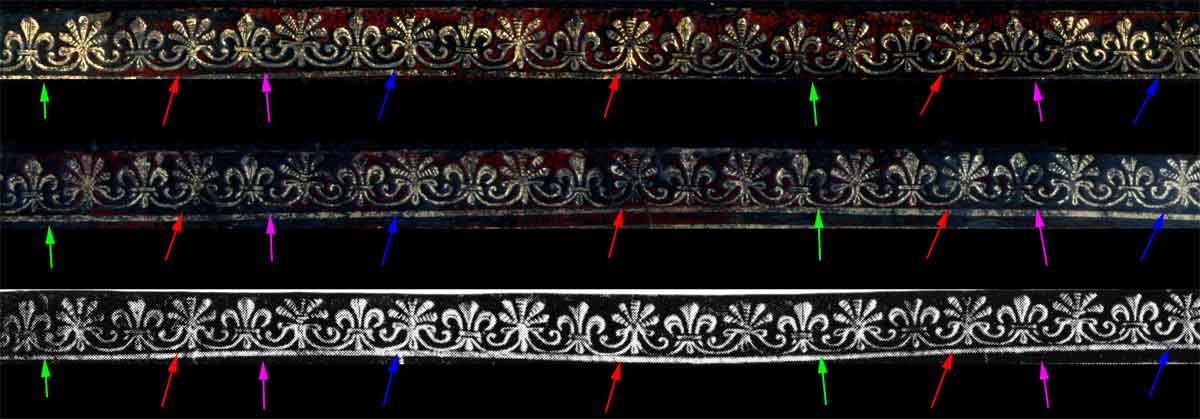
| In the Comparative Diagram shown above, we see two colored sections of roulette from our Dauphin binding and compare these with a black and white example from item 926. These roulettes are so well made that it is hard to find specific differences so as to be able to match up samples from the same binding however after a long search I have located details which will allow us to see identical sections of the roulette. Now if we can find these same features in the 926 samples then we have a match. Starting with the green arrows, these are pointing to a rather large open space where the arm of the fleur de lis meets the foot of the next fleur (fleur de ?), compare this to the narrow space indicated by the purple arrows. Similarly, the red arrows are pointing to a narrow opening and the blue to a larger opening. We can see that there is no radical departure from this arrangement in any of the aligned segments, thus they must all derive from the same Boyet roulette (roulette D for Dauphin) |
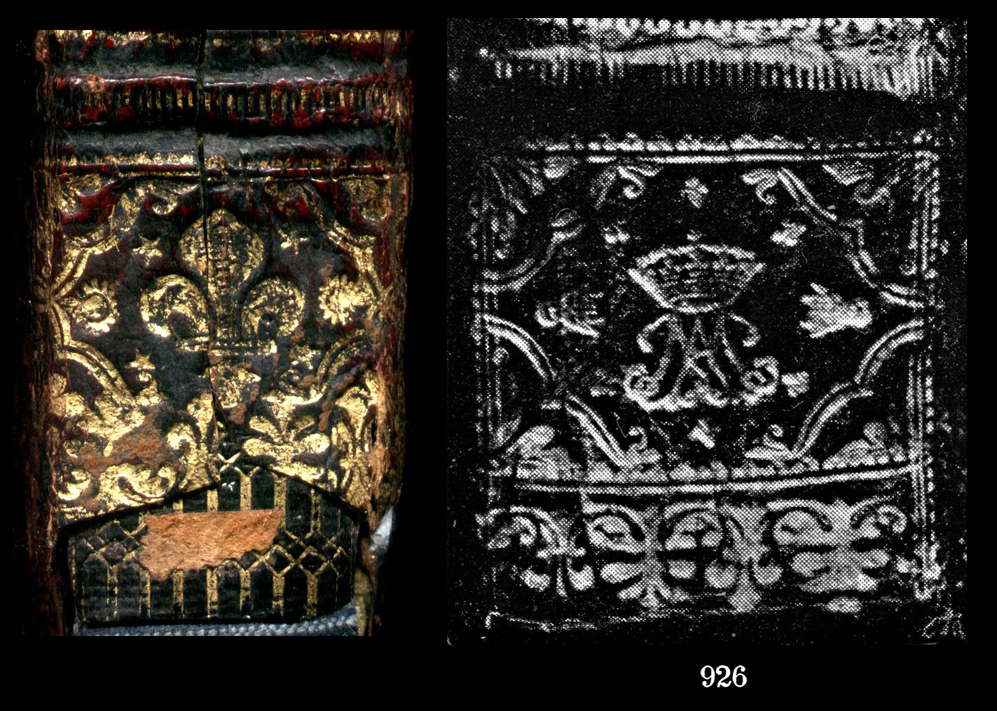
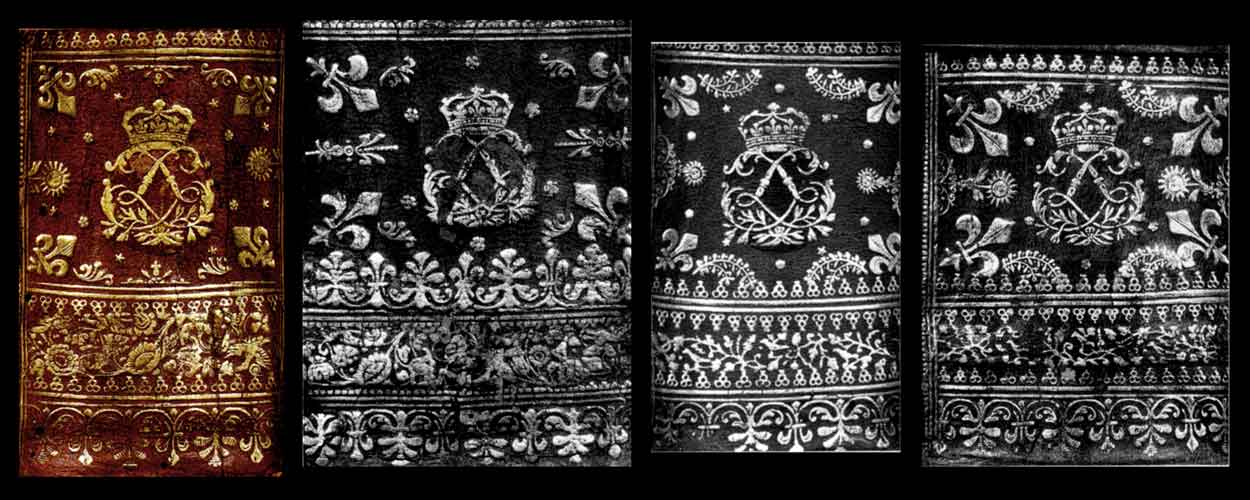
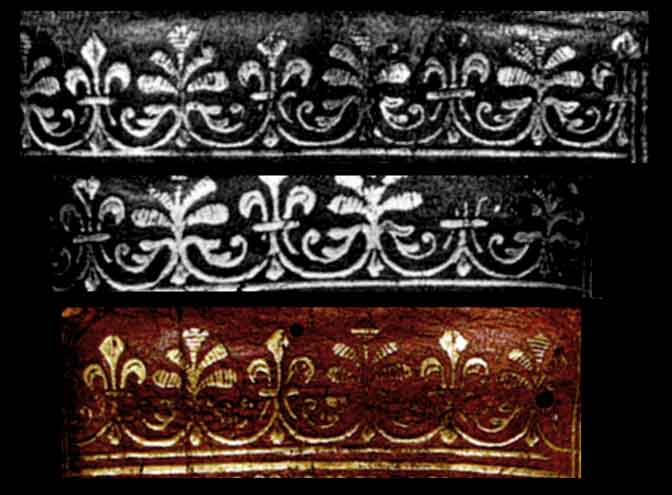
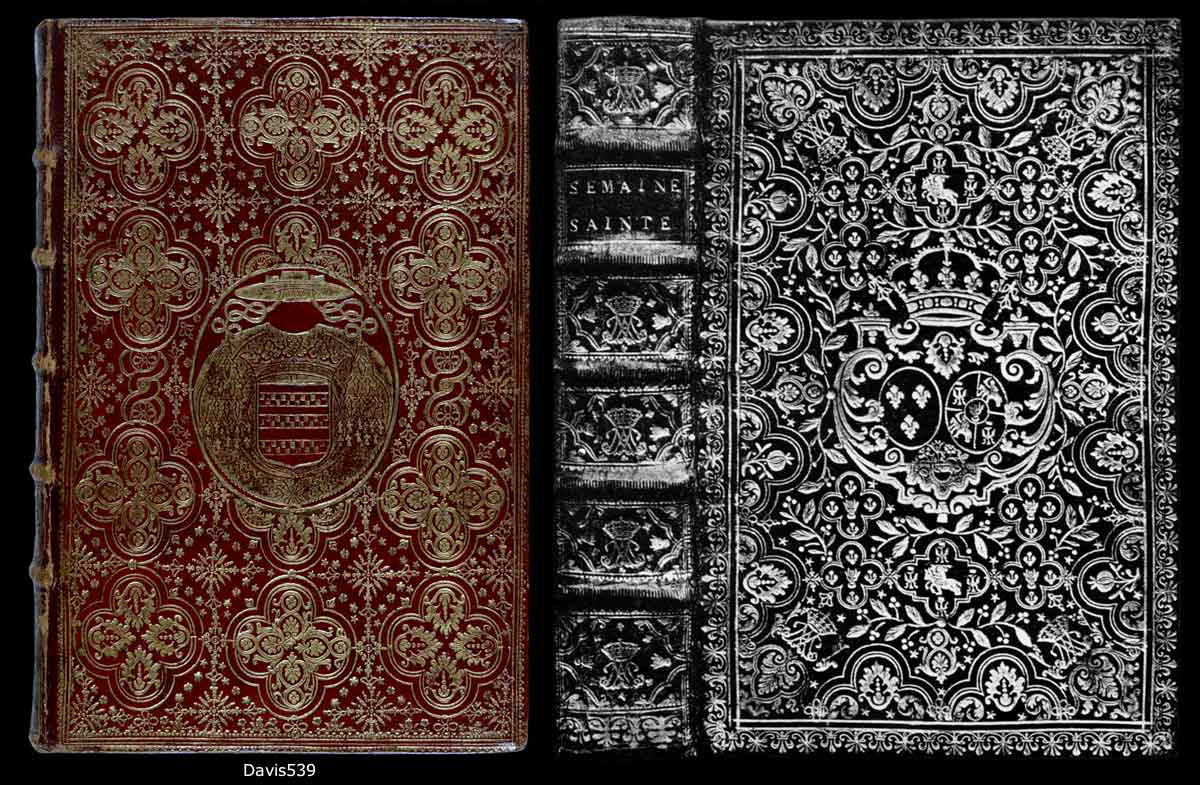
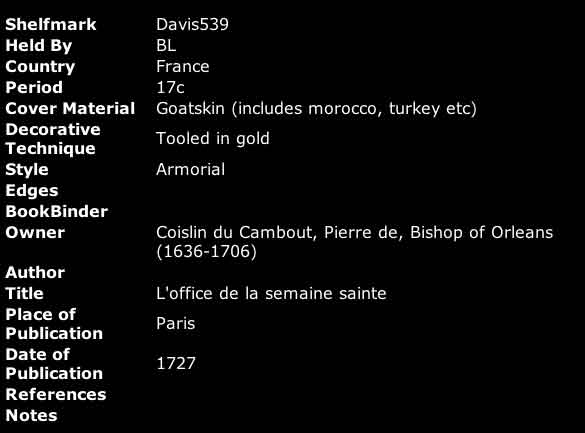
| Now we can look at a binding from the British Library Database of Bookbindings, shelf marked Davis539, it is not what anyone would call an obvious Boyet, however let us now compare imprints. The most obvious imprint in sight is this one shown below in Comparative Diagram 6. Here I have taken an imprint from the Davis539 binding which I have previously rescaled to it's correct size at 300 dpi. This I have placed over a similar imprint from binding 926 which I have also rescaled exactly by matching the roulettes with the scanned roulettes of the salvaged Dauphin binding. Thus the davis539 imprint forms an overlaying layer, which I have transformed to a semi-transparent state as well as inverting the color. This gives us a darker,blue colored imprint, that overlays the white imprint underneath. We observe that they match up very well, indicating that not only is this the same imprint, but that the scale of both is the same. Click on this diagram to see an enlargement, the upper layer has been shifted slightly upwards and to the right to allow us to see clearly the white imprint beneath. |

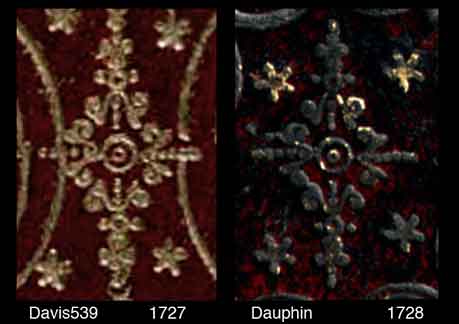
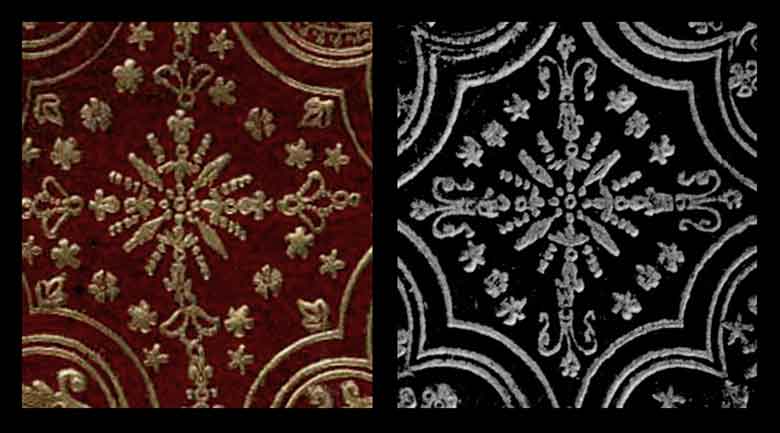
|
Below we find two more examples, each taken from a different source, look closely this is not the same binding in a different position these are two separate but very similar bindings. Binding 92 (shown with the spine included,) is from an Ader Tajan auction catalogue, Drouot, Paris 4 juin 1993. The second example is from a 1927 album of plates that are meant to complement an auction catalogue (that I don't have!). Paris, Giraud-Badin (Lemallier). With only an album of plates, I do not know any of the details about this binding other than it being lot No. 40 of that auction, (Vente du Lundi 21 au Jeudi 24 November 1927 Hotel Drouot Paris). The important thing to note (from the listing's details reproduced below) is that binding 92 contains a 1732 Collombat OSS. These bindings, that are so similar, were certainly some of the last to come from the atelier of Boyet, who died on Sunday the 22nd of February, 1733 at 11 AM. He would have been about 75 years old at that time according to the estimate of Thoinan, who notes further, that a certain Michel Daragon, a relieur since 1720, looked after Boyet's shop after his death and completed Boyet's unfinished work. We might guess that at 75, Boyet might not have been doing the gold tooling himself, and might have in fact, employed Daragon long before, who else could have completed the Masters work? |
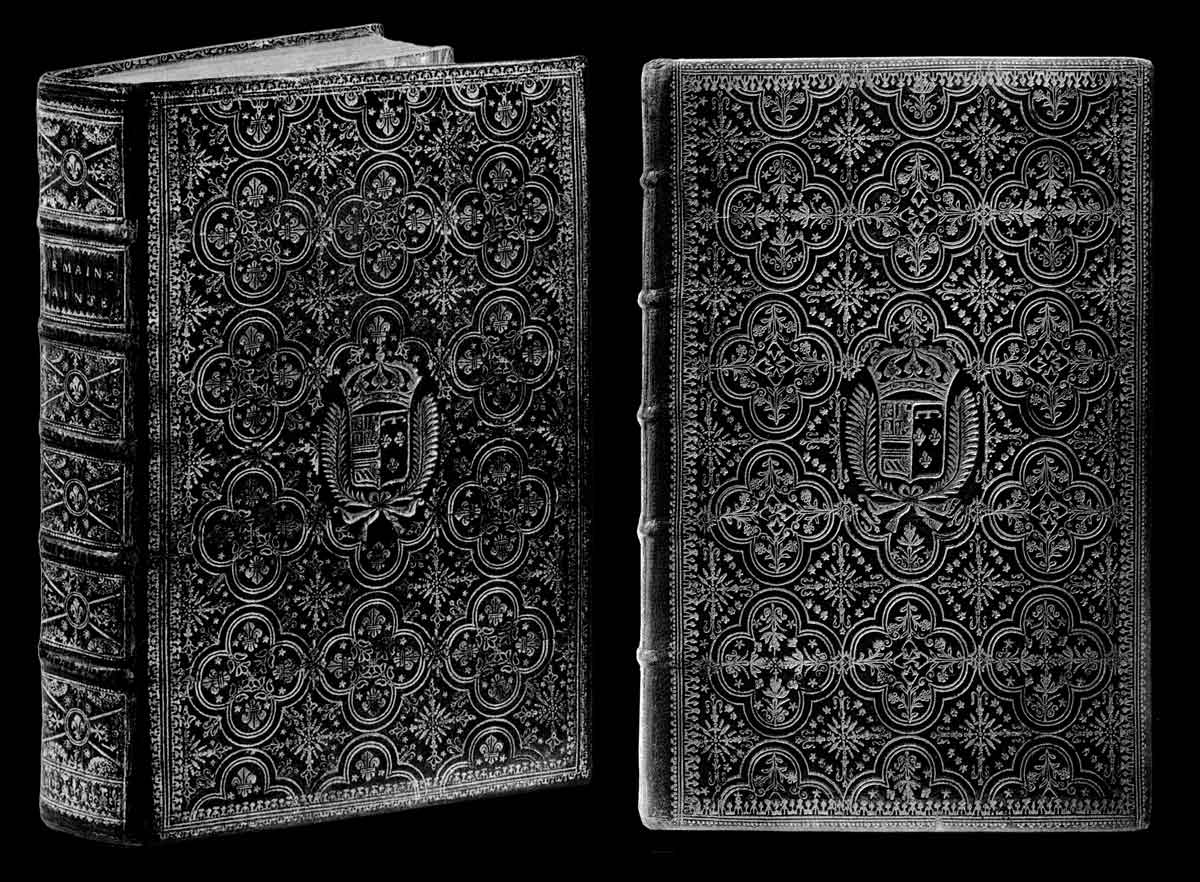
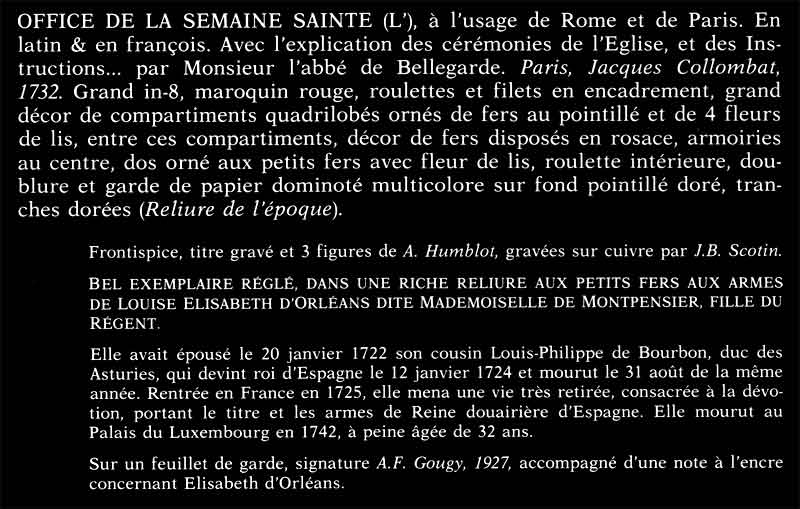
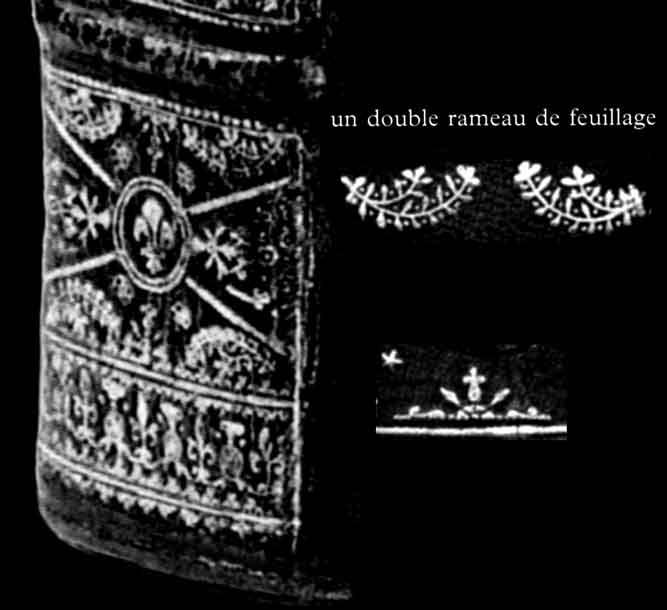
| In the Comparative Diagram 9, I show an enlarged detail of the spine of binding 92, along with imprints that have been singled out as deriving from authentic Boyet tools by Jeanne-Marie Métivier who has written a short paper entitled Luc-Antoine Boyet, relieur de l'Imprimerie royale (1704-1723) which was published in la Revue de la Bibliothèque nationale de France, numéro 12, 2002. In Comparative Diagram 4, I have reproduced 4 spine compartments which are authentic Boyets according to Jeanne-Marie Métivier's careful research. The same imprint which she describes as "un double rameau de feuillage" can be found decorating these compartments, they are also seen on many of the Boyet bindings illustrated in the 2002 Paris publication entitled: Reliures françaises du XVIIe siècle : Chefs-d'oeuvre du musée Condé, by Isabelle de Conihout & Pascal Ract-Madoux. Here the authors present a number of bindings that they attribute to Luc-Antoine Boyet. I have detailed these particular imprints, as well as other important Boyet imprints, on a page entitled, Luc-Antoine Boyet - Tool Identification 1689 (click here to see this page). |
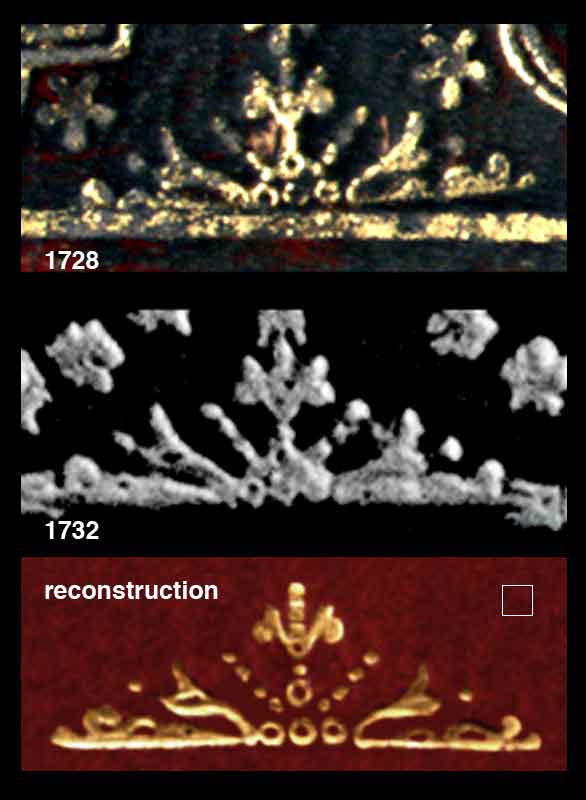
| Although there are many imprints we could explore, here especially those of binding 926, I will just concentrate on one small, hardly noticeable imprint which I first noticed while exploring a high resolution scan of a Boyet doublure some years ago. Barely visible due to being placed over existing tooling, it is more obvious in the diagram below due to the fact that the directional light of the scanner has illuminated part of it's raised surface. |
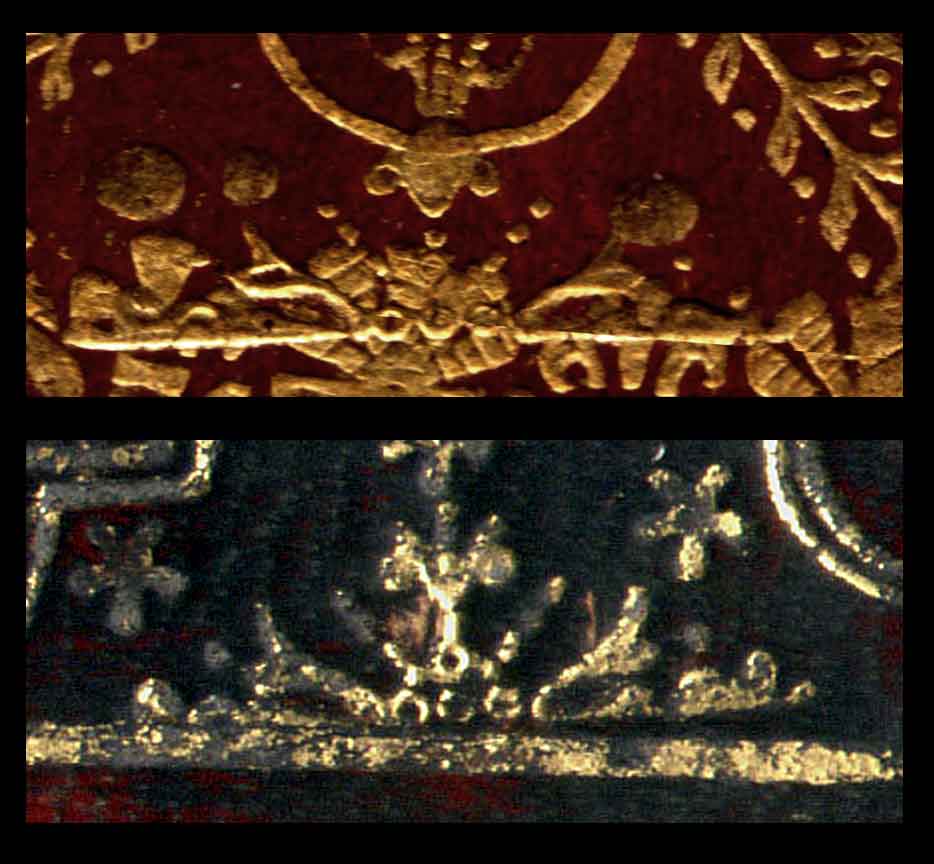
| This unusual imprint is tiny, and yet are so distinctive that you would recognize it anywhere (if you can spot it), Below I have I have photographed our Dauphin binding in bright sunlight so that these tiny imprints might become more visible. We can see that they are placed beside the filet and have also been placed along the side of the coat of arms in both the Dauphin 1728 and 1732 example. |
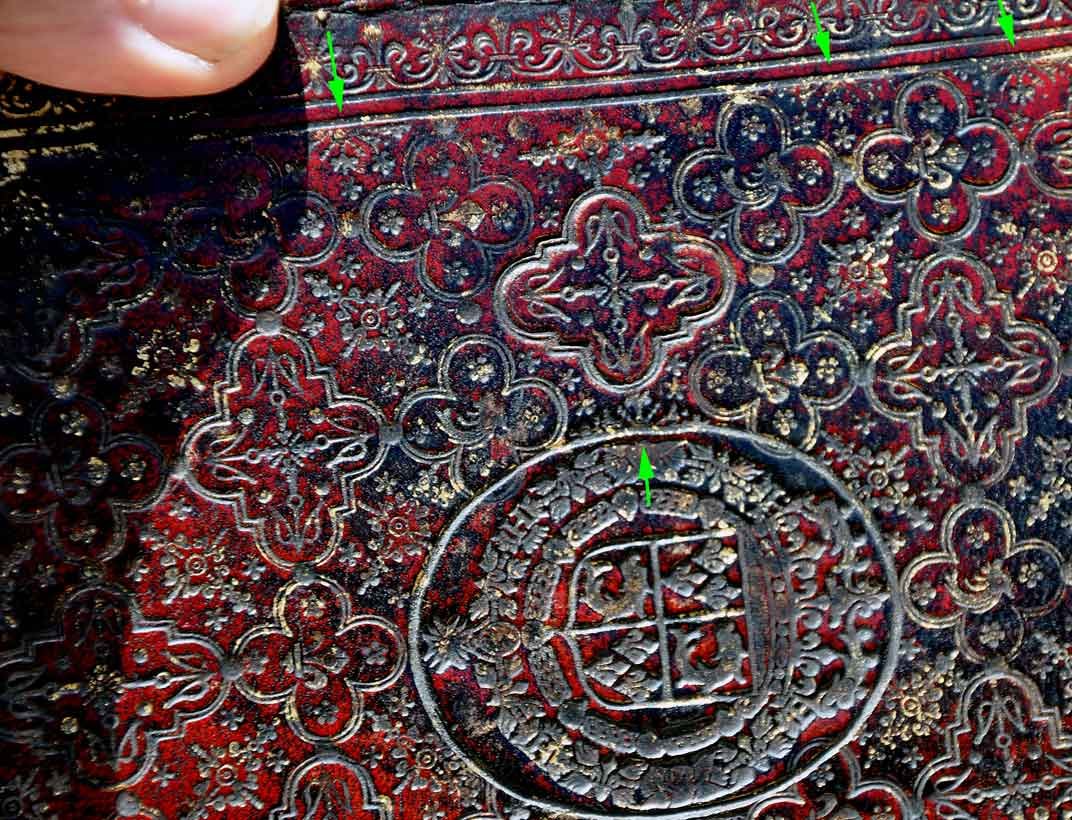
|
See also Luc-Antoine Boyet- 1693 Tool Identification or try this page. Decorative Dentelle by Luc-Antoine Boyet |
| Click on this link to return to Virtual Bookbinding | link to the home page of cyclopaedia.org |